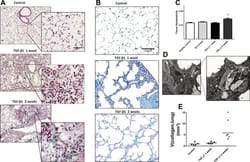Lopez-Rodriguez, E., Pascual, A., Arroyo, R., Floros, J., Perez-Gil, J.: Biophys J. 2016;111(3):524-36.
To access the full article, click here:

Pulmonary surfactant is a lipoprotein complex that reduces surface tension to prevent alveolar collapse and contributes to the protection of the respiratory surface from the entry of pathogens. Surfactant protein A (SP-A) is a hydrophilic glycoprotein of the collectin family, and its main function is related to host defense. However, previous studies have shown that SP-A also aids in the formation and biophysical properties of pulmonary surfactant films at the air-water interface. Humans, unlike rodents, have two genes, SFTPA1 and SFTPA2. The encoded proteins, SP-A1 and SP-A2, differ quantitatively or qualitatively in function. It has been shown that both gene products are necessary for tubular myelin formation, an extracellular structural form of lung surfactant. The goal of this study was to investigate potential differences in the biophysical properties of surfactants containing human SP-A1, SP-A2, or both. For this purpose, we have studied for the first time, to our knowledge, the biophysical properties of pulmonary surfactant from individual humanized transgenic mice expressing human SP-A1, SP-A2, or both SP-A1 and SP-A2, in the captive bubble surfactometer. We observed that pulmonary surfactant containing SP-A1 reaches lower surface tension after postexpansion interfacial adsorption than surfactants containing no SP-A or only SP-A2. Under interfacial compression-expansion cycling conditions, surfactant films containing SP-A1 also performed better, particularly with respect to the reorganization of the films that takes place during compression. On the other hand, addition of recombinant SP-A1 to a surfactant preparation reconstituted from the hydrophobic fraction of a porcine surfactant made it more resistant to inhibition by serum than the addition of equivalent amounts of SP-A2. We conclude that the presence of SP-A1 allows pulmonary surfactant to adopt a particularly favorable structure with optimal biophysical properties.



